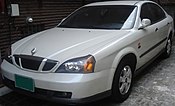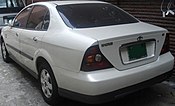This article needs additional citations for verification. (November 2018) |
| Daewoo Magnus (V200) | |
|---|---|
 Daewoo Magnus (pre-facelift, South Korea) | |
| Overview | |
| Manufacturer | Daewoo (General Motors) |
| Also called |
|
| Production | 2000–2006 2005–2006 (China) 2002–2006 (Vietnam) |
| Assembly | Vietnam: Hanoi (GM Vietnam) |
| Designer | Giorgetto Giugiaro at Italdesign |
| Body and chassis | |
| Class | Mid-size car (D) |
| Body style | 4-door sedan |
| Layout | Front-engine, front-wheel-drive |
| Powertrain | |
| Engine | |
| Transmission | 5-speed manual 4-speed automatic |
| Dimensions | |
| Wheelbase | 106.3 in (2,700 mm) |
| Length | 187.8 in (4,770 mm) |
| Width | 71.5 in (1,816 mm) |
| Height |
|
| Chronology | |
| Predecessor | |
| Successor |
|
The Daewoo Magnus is a mid-sized sedan developed and manufactured by Daewoo for model years 2000–2006 under a single generation, and marketed globally by GM Daewoo and other General Motors divisions, as well as GMDAT stake holder Suzuki. Developed under its internal Daewoo designation V200, the Magnus was marketed prominently in the United States as the Suzuki Verona.
The V200 is a successor to the Daewoo Leganza (model V100), used a larger chassis of its platform.[2] Launched in 23 November, it was sold alongside the Leganza in Korea until the end of V100's production in 2002, when it also superseded it in export markets. The V200 itself was given an extensive facelift for 2006, which resulted in the model known as V250, or Daewoo Tosca in Korea. The V250 completely superseded all versions of the V200 during 2006.
The Evanda comes equipped with the Daewoo-developed XK6 inline-6 engine (DOHC 24V, 155 hp (116 kW) at 5800 rpm, 177 lb⋅ft (240 N⋅m) of torque at 4000 rpm – Canadian specification) or a Holden-built 2.0 L D-TEC inline-4 (DOHC 16V) carried over from the Leganza. Italdesign of Italy was responsible for the styling and design of both the Leganza and Magnus. However, the upcoming V250 was styled in Korea by GM Daewoo.
Chery Automobile may have used the platform of this car on Chery Eastar, Chery A5 and Chery Tiggo 3.[3]
-
Daewoo Magnus (pre-facelift, South Korea)
-
Daewoo Magnus (facelift, South Korea)
-
Daewoo Magnus (facelift, rear view)
- ^ "FORMOSA. FORMOSA in TAIWAN". 8 July 2011. Archived from the original on 8 July 2011. Retrieved 19 April 2018.
- ^ "중형세단에 직렬 6기통 시대를 연 대우 매그너스". hankookilbo.com. 22 August 2017. Retrieved 1 February 2020.
- ^ Breevoort, Leo (31 July 2023). "The Big Read – Chery (2/4) – The Daewoo affair". CarNewsChina.com. Retrieved 29 July 2024.


